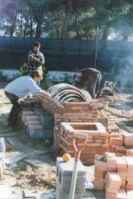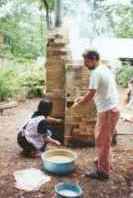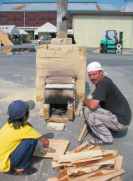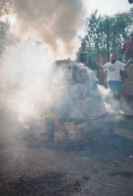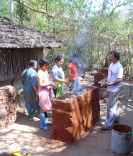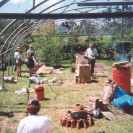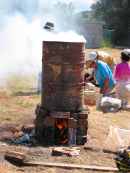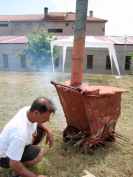|
|
 |
Kilns | Car Kiln | Wood Kilns | Pottery Kilns | Paperclay | Fire Trees | Constructs
My wood kilns are generally very simple structures, which are used to teach the elements of kiln building. They can be updraft, downdraft or crossdraft - high fire or low fire.
Most kilns are designed to either self-fire (paperkilns series, for example) or which require constant stoking
Building Wood fired Anagama in Alicante, Spain
Construction techniques. Instead of split bamboo we used strips of Formica, which was supported by battens in a 'V' shape with a central support.
This allowed us to vary the shape and form of the kiln. It is relatively small and designed to be fired by two people. |
Papering over the cracks!
Downdraft wood fired kiln.
This kiln is based on the traditional Arab style wood-fired updraft kiln commonly found in Spain. The firebox is under the chamber but I have changed the design so that the path of the flame is through the chamber and down across the floor to the chimney.
I have found that this design is perfect for wood-fired Spanish lustres, which is what we are doing here in the picture during a workshop in Mie, Japan. |
Workshop with kids Aoyama, Japan
During my residency in the IGA programme in Aoyama 2004 I was expected to run workshops for kids. Apart from the usual clay modelling, I decided to show the kids how we could fire the work as we did not have any facilities for doing so.
This simple updraft kiln was built by just piling up bricks to form a chamber, which was then covered over by paper and slurry. We got to approximately 900° in four hours with the kids helping to stoke. |
Firing Paper Kiln in Spain
I first came across the paperkiln during a ceramic event organised by the Catalan Potters Association in 1987 in Spain. Fina Casaus demonstrated this technique to all of us.
Since then, I have developed this technique to be flexible, which allows us to create variable atmospheric conditions within an enclosed space, changing combustibles and the use of metallic salts.
Here the paperkiln is being demonstrated at the Ramon Fort summer school in Llers, Spain. I first started teaching here in 1995, mainly doing experimental firings and kiln building.
|
The Wall
The wall is a very narrow brick kiln that looks like a wall. It is very flexible in terms of construction, allowing you to make it as long and as high as you want. The wall kiln is wood fired and is usually packed with pots layered with wood or any other combustible be it charcoal, cow dung, straw, leaves etc.
This kiln was demonstrated at Good Earth, Alibag, Bombay for a group of studio potters. |
The Battlefield
Workshop with Espacio Ceramico in Galicia, Spain. During this workshop several kilns were built and fired, using a variety of combustibles and techniques.
Experimentation was the key and having the kilns firing at the same time, being dismantled or built created the sensation of a battlefield.
|
Cantaki!
The first international ceramics festival, Nigran 2004.
This wood fired kiln is very simply a drum placed on a foundation of bricks.
Cans come in various sizes and can be piled up one on top of the other according to the number of pieces or size of the work.
The pieces are placed between wood and charcoal and continuously stoked from the bottom. Quite high temperatures can be reached and depending on the type of treatment to the clay surface some spectacular results can be achieved. |
Le Four Mobile
During my residency at Art-Sud on the island of La Reunion in the Indian Ocean 2002. This is where I invented the Four Mobile because I found shopping trolleys abandoned all over the place near the arts centre, which was beside a supermarket.
Basically it is a development of the paper kiln but in a more imaginative way. It is also wood fired.
This Four Mobile was demonstrated in Galicia Spain, 2004. |
|
 |

